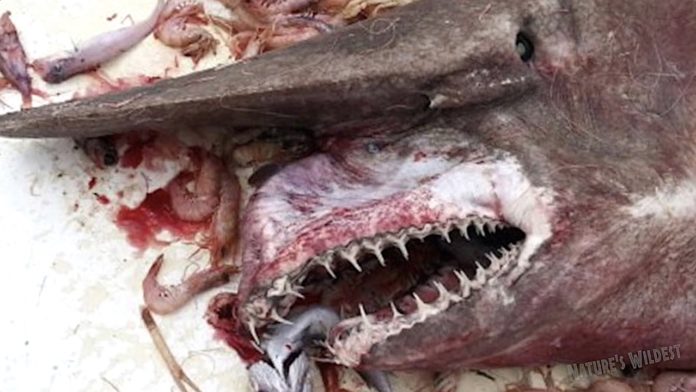The Goblin Shark, scientifically known as Mitsukurina owstoni, is one of the ocean’s most fascinating and enigmatic creatures. Often referred to as a “living fossil,” this species is the sole surviving member of the Mitsukurinidae family, with a lineage dating back approximately 125 million years. Here’s everything you need to know about this unique deep-sea dweller.
Distinctive Physical Characteristics
Goblin sharks are instantly recognizable by their peculiar appearance. They possess:
- A Long, Flat Snout: Known as a rostrum, this elongated snout helps the shark to detect prey in the deep, dark ocean. It’s equipped with numerous ampullae of Lorenzini, sensory organs sensitive to the electrical fields produced by other sea creatures.
- Protruding Jaws: One of the most striking features is their ability to extend their jaws rapidly to capture prey. The jaws can extend nearly 10% of their body length, giving them a terrifying and effective method to ensnare food.
- Teeth and Skin: Their teeth are needle-like and perfect for grasping slippery prey. The skin is translucent with a pinkish-gray hue, which turns more gray after death due to the lack of pigment.
- Size: These sharks can grow up to 3.8 meters (12.6 feet) in length, with some individuals possibly reaching 20 feet, though such sizes are rare.
Habitat and Distribution
Goblin sharks are deep-sea dwellers, living at depths ranging from 40 to 1,200 meters (130 to 3,940 feet). They are found in:
- The Atlantic, Pacific, and Indian Oceans: However, most sightings have been off the coast of Japan, particularly in the bays of Sagami and Suruga.
- Benthopelagic Zone: They live near the bottom in areas like continental shelves and slopes, where they can hunt for food in the dark, cold waters.
Behavior and Diet
- Hunting Strategy: Due to their slow speed, goblin sharks rely on ambush tactics. They use their extended jaws to quickly capture prey like fish, squid, and crustaceans in the low-light conditions of the deep sea.
- Feeding Mechanism: Their unique jaw mechanism allows them to create a vacuum to suck in prey, which is then secured with their sharp, pointed teeth.
Reproduction and Lifespan
- Reproductive Habits: Goblin sharks are ovoviviparous, meaning the embryos develop inside eggs within the mother’s body until they are ready to be born alive. Details like gestation period or the number of pups remain largely unknown due to the scarcity of live specimens.
- Lifespan: Information on their lifespan is sparse, but like many deep-sea creatures, they likely grow slowly and have a long life.
Conservation Status
The goblin shark is listed as “Least Concern” by the IUCN Red List, primarily because their deep-sea habitat keeps them out of direct human interaction. However, incidental capture in deep-sea fisheries remains a concern.
Why the Goblin Shark Matters
Beyond their eerie appearance, goblin sharks play an essential role in the deep-sea ecosystem. They help control the populations of various deep-sea creatures, maintaining a balance in this mysterious underwater world. Understanding more about goblin sharks can offer insights into the health and biodiversity of deep-sea environments.
In summary, the goblin shark is not only a marvel of evolutionary biology but also a reminder of how much of the ocean remains unexplored. By diving into the specifics of their physical attributes, habitat, and lifestyle, we gain a deeper appreciation for the complexity of marine life..






